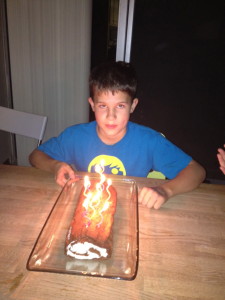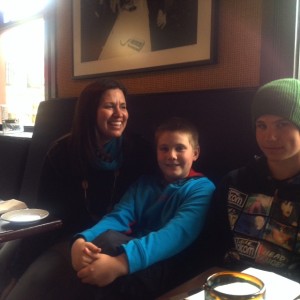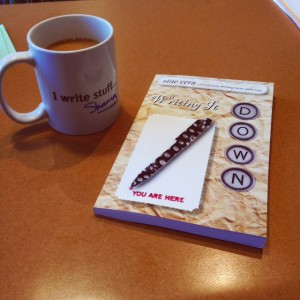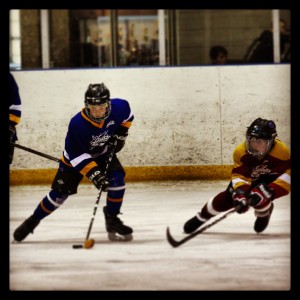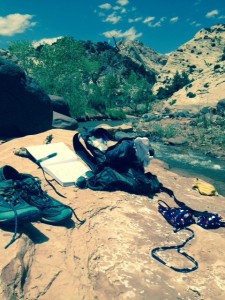 I loaded my small backpack with a few granola bars, a red apple and water bottle, put my bikini on under my shorts and tank top, slid on some water friendly hiking shoes, grabbed my camera, my black leather journal, headed out the door of the field station and walked down the orange dirt road that lead to Pleasant Creek.
I loaded my small backpack with a few granola bars, a red apple and water bottle, put my bikini on under my shorts and tank top, slid on some water friendly hiking shoes, grabbed my camera, my black leather journal, headed out the door of the field station and walked down the orange dirt road that lead to Pleasant Creek.
A moth the color of a lilac bush and the size of a quarter fluttered across the path and settled on a petite yellow flower with long, pale tentacles a few feet to the right of the trail. The wind brushed through the juniper and pinion trees and I was hit in the face with a wave of dry, hot wind as it traveled across the sandy soil, rough rock walls and the through the flora. Shit. I had forgotten how high desert wind moves me through time as if it does not exist. I ran my hand along the gritty, dark-red sandstone and contemplated the sheer size of the park.
I hadn’t been to the high desert since my divorce two years ago. I used to spend long, leisurely weekends with my two boys and their dad at the cabin we had built on 10 acres in the high desert of Fruitland, Utah. We had hand built a 100 square foot camping cabin, fire pit, a shed and several small tree forts among the juniper and sage plants.
It has been two years since I sold the property. Two years since I shut the door of the small, green cabin and fell into a small heap on the bamboo floor while the boys played outside for one last time. Two years since I found a small bouquet of wildflowers my young son placed on the steering wheel of our truck as I loaded it with the last of our last belongings. The cabin had been my respite from the world, my escape, and my inspiration—my muse.
I have always been fascinated with the word muse. I used to think of it as mysterious, enchanting, and forbidden—as if one must belong to an elite category of male artists in order to obtain a beautiful woman as a source of inspiration. I felt like I was not artistic or eccentric enough to obtain a muse (and I was not the correct gender), and I briefly thought it would be ideal to be a muse. When it came down to it, I did not feel attractive or playful enough to personify a muse. To me, a muse was linked to sexuality and beauty.
As I started writing, I came to realize that my old definition of a muse was superficial. Creativity and inspiration run much deeper than sexuality; a muse is more of a guide to our deepest thoughts, to the core of emotion and spirit. A muse serves as a refuge while shedding light on our darkest thoughts and secrets, it is a safe space to simply exist, simply be. A muse can be a person, a place, or something you do.
The wilderness has always been favorite escape. I seek refuge in the wild, I seek entertainment and I seek beauty. Tears have streamed down my face while I have punished myself by exhausting my legs on long hikes, I have kicked innocent trees to let out my frustrations, I have descended long rappels and traversed exposed ridges while learning to focus on the moment and I have let go of my fears and trusted my abilities to navigate through difficult rapids. I have pushed gravity by going too fast on my snowboard, and paid the price with a few broken ribs. I have lost trust in myself and found it again sitting among giant Redwoods. The wild is always there, always willing to entertain me and provide refuge for contemplation. I seek out the silent roar of solitude.
The sun got stronger and the canyon walls got thinner as I walked along Pleasant Creek. Every time I came to the creek I would bend down and splash water on my legs and arms and hair. The wind was hot and I would dry within minutes. Large black rocks dotted the trail and sat in contrast with purple, red, orange, white and yellow flowers in fields of red sand. Slowly, the canyon turned from a rich, deep red to pale white Navajo sandstone. I was getting hungry and started to look for a place to rest. As I rounded a corner I came to a large piece of sandstone resting under a Cottonwood tree next to the water, and deep pools formed in the creek.
The rock was warm and I took out my granola bars and apple, wishing I had packed a more substantial lunch. A small cloud of gnats hung over my head and buzzed loudly, lessening the sound of the water in the creek. A carpenter bee grazed my hair. A lizard came over to say hello and did a few push-ups on his front arms before disappearing again.
One of the pools of water looked deep enough that I could get fully submerged. I took off my hiking boots and walked to the edge of the creek. My top came right off, but I hesitated before I took off my bottoms—suddenly shy. The cold took my breath away as I steadied myself with my hands and slid onto a rock in the stream. Water bubbled around me. I lay back to become fully submerged and released my grip on the rocks. The current of the stream was stronger than I had anticipated, and it lifted me and pushed me down stream about six feet. The flesh on the backs of my legs and bottom scratched against the sandstone lining of the creek bed. Startled, I grabbed hold of any rock I could and sat up.
This wasn’t the peaceful scene I had imagined it would be, and the small scratches on my legs stung. Unwilling to leave the stream bullied and injured, I leaned back again and let the cool water chill me to my core. I released my stone cold grip. The current pushed me a little farther down stream to where the water pooled. I came to rest, nude, eyes closed, three quarters submerged. I floated there, like a piece of driftwood, until I was covered in goose bumps.
I got out of the creek and lay on my belly on the large slab of sandstone, where I had eaten lunch. My flesh matched the reds, browns and white of the strata around me. I, too, had ripples and lines from age. As my body melted into the hot sand stone—my forearms, cheek bone, breasts, belly, and thighs—I thought of two white moths I had seen earlier on the trail. Their dance, their flight, looked like it came so easily to them.

